When and how to properly prune grapes in spring for beginners step by step: instructions and diagrams
With proper care, grapes can bear fruit for several decades. Even an old vineyard can be revived with anti-aging pruning. In spring, young plants are sheared for shaping using suitable patterns and damaged and dry branches are cut. In this article, you will find step-by-step instructions for beginners on how to prune grapes in the spring.
The content of the article
Purposes of Spring Pruning Grapes
The culture has the unique ability to direct nutrients to young shoots. This property has been developed and improved over the centuries. In the wild, branches stretched upward, trying to get the maximum amount of solar energy. For this reason, in the middle and lower parts of the bush, the eyes develop slowly and sometimes do not shoot at all. That is why growers regularly prune their grapes.
Spring pruning of grape bushes is aimed at increasing fertility and giving a neat shape. Correct pruning improves ventilation and sun exposure. This is one of the main tasks of the gardener, the neglect of which leads to thickening of the plantings, a decrease in pollination, and the peeling of berries.
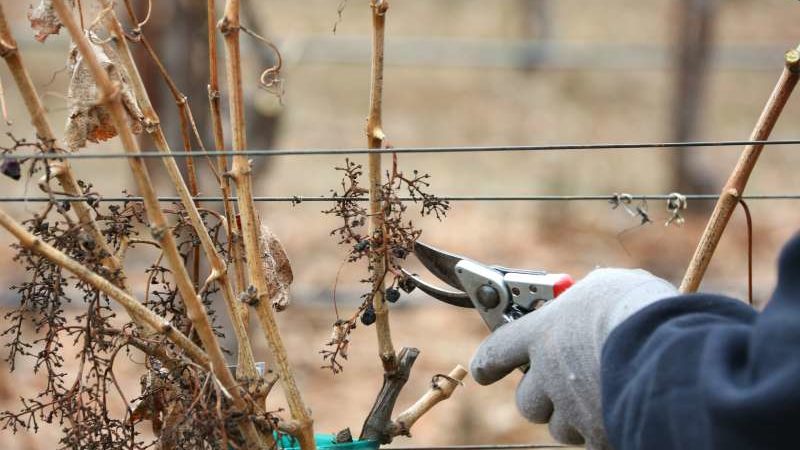
Advantages and disadvantages of the procedure in the spring
Spring Pruning Benefits:
- increase in productivity by 60-80%;
- forming bushes of the correct shape;
- increased frost resistance;
- improving plant nutrition and maintaining photosynthesis;
- simplified care and harvesting;
- ensuring free access to the vine from all sides.
This method has no drawbacks. The main thing is to start work before the moment of sap flow, otherwise the plant will die due to a large loss of moisture.
When to prune in spring
Timing of pruning of vines is extremely important for bud ripening, yield and quality of berries. Spring pruning is divided into early and late.
Early pruning is done after the snow has melted. As soon as the air warms up to a stable + 5 ° C, the growers arm themselves with tools and start working. During this period, sap flow has not yet begun, so the sections will quickly dry out and tighten. In extreme cases, the procedure can be performed until the first buds swell.
Late pruning is carried out when the shoots have reached 5-6 cm in length. This procedure is performed in regions where there is a high likelihood of recurrent spring frosts. Late pruning is recommended only if absolutely necessary, and even better to transfer it to autumn. It severely depletes grapes and slows down the growth of new shoots.
Reference. In the regions of central Russia (Moscow region), the sap flow of grapes begins in the 1st-2nd decade of April, in the southern regions - at the end of March.
Auspicious days
Favorable days for pruning according to the lunar calendar for 2020:
- March - 11.12, 16-18, 24-26;
- April - 11-14, 21.22;
- May - 10, 11.
Favorable days for pruning according to the lunar calendar for 2021:
- March - 17-19, 22.23, 26-28;
- April - 13-15, 19, 24-17;
- May - 12-17, 24-26.
Types of trimming
Among the types of grape pruning, there are formative, rejuvenating and sanitary.
Formative pruning helps regulate the load on the bush with vines and berries. In the first year of development, the seedling does not need special care. For proper growth, it is enough to cut off the growing shoots. The seedling is tied to a support and left alone until the next season. In the second year of development, they choose a suitable pruning scheme for shaping the bushes and adhere to a single course.
Anti-aging pruning is carried out from the moment the first signs of aging of the bush are detected. This is indicated by the poor development of shoots, a decrease in yield and pea berries. Sometimes growers resort to extreme measures and completely prune the bush, performing a complete "reset" of the plant. The procedure is carried out in summer or autumn, following the scheme:
- The base of the bush is dug in 10-15 cm deep.
- Then the ground trunk is completely cut off at a height of 5-10 cm.
- The cut is treated with wax or garden varnish.
- The cut bush is covered with loose and fertile soil.
- In the spring, the land is harvested, after which the young shoots quickly grow and gain strength.
Sanitary pruning is done in the spring. The bushes are carefully examined after hibernation and dry, diseased and damaged branches are removed.
How to prune grapes correctly
For hundreds of years, winegrowers have determined several general rules for pruning a culture, guided by which even a person without experience can cope with the task.
Required materials and tools
List of tools for pruning grapes:
- Pruners are used for pruning annual and biennial branches up to 1.5 cm in diameter, as well as thin sleeves. To get even, neat cuts, gardeners use double-bladed pruners.
- The bow saw is used to trim perennial shoots with a diameter of 7-8 cm.
- The hacksaw is suitable for cutting branches with a diameter of 8 cm.
- The lopper is a type of pruner. The tool is suitable for branches in hard-to-reach places. It is attached to a stick, a certain branch is hooked and cut off by pulling on the twine tied to the lever.
- The budding knife is used for budding the eyes.
- The grafting knife is suitable for grafting vines with cuttings.
Before use, tools are sharpened if necessary and disinfected in medical alcohol or a strong solution of potassium permanganate.
Reference. The sleeves are perennial branches that form throughout the life of the plant and grow in size each year due to the shoots left during pruning.
Step-by-step instruction
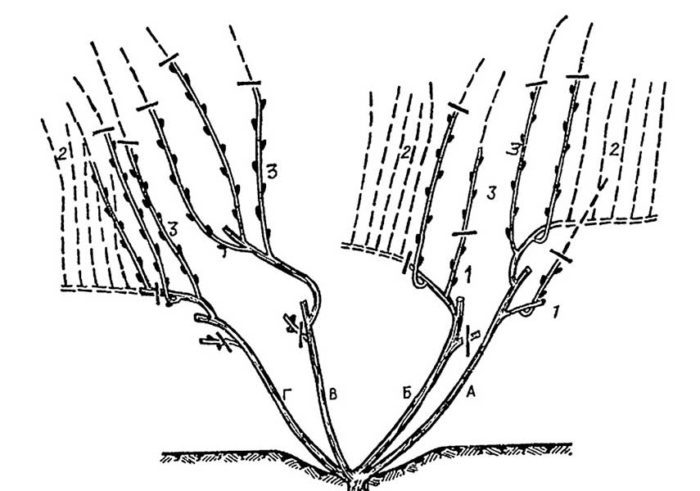
Pruning rules:
- The cut is performed at an angle of 90 ° perpendicular to the branch. This allows for faster healing due to the smaller wound area compared to cutting at an acute angle.
- Sick and dead vines are completely removed.
- 7-12 eyes are left on the shoot.
- Fruiting annual shoots are carefully cut off, trying not to damage the wood. Slices are made at the base of a perennial shoot, leaving a stump of 0.5 cm.
- Healthy shoots with a diameter of 6-10 mm are left for fruiting. Thin and thick shoots (with a circumference of more than 10 mm) must be cut off without fail.
Pruning schemes
Growers use several pruning schemes for grape bushes:
- by the Guyot method;
- fan;
- Moscow Small Fan;
- horizontal cordon.
Guyot pruning

This simple scheme aims to grow one strong shoot. In autumn, all young shoots that have grown over the summer are cut off, and the main one is shortened by 5-6 eyes.
Reference. If the main shoot is weak, it is completely removed and the molding is transferred to the next season.
In the spring, the fruit arrow is tied to the trellis in a horizontal position. If there are two shoots left on the bush, they are tied up so that they look in different directions. Thus, it is possible to obtain a two-armed bush according to Guyot. Shoots of fruiting vines are tied vertically to the second and third wires as they grow.
In the third year, the vine gives its first harvest.In the autumn of the same year, the stem is completely freed from inflorescences and stepsons. In the next season, the vine is lengthened by 10-12 eyes, bringing their number to 20. In each subsequent season, the steps of the method are repeated.
Fan model
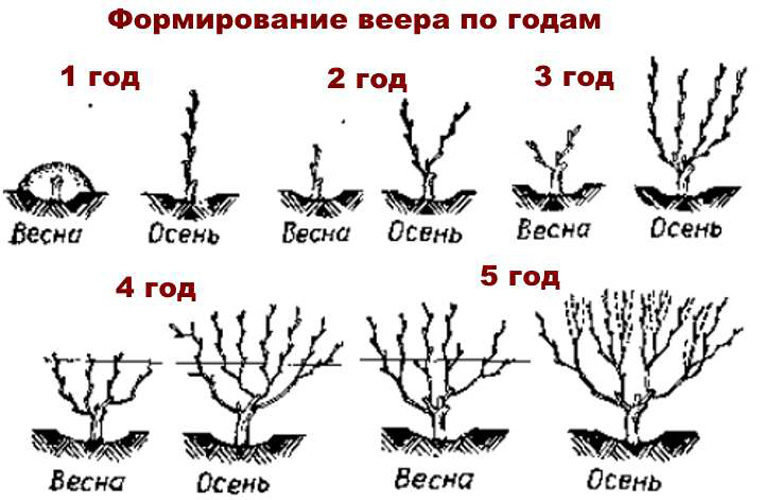
The fan pattern assumes the formation of two short sleeves located in the same plane at different angles of inclination. Thanks to this molding, the vine can be easily removed from the trellises in the fall and covered for the winter. The grape bush is constantly being renewed, and the yield is increasing.
Moscow small fan
With this molding scheme, the bushes are located at a distance of 70-80 cm, the row spacing is 1.5-2 m. This allows you to cover the bushes for the winter with grass and dry branches. The vine breathes freely, thanks to which it lives for more than 10 years. The scheme is often used in northern regions.
Horizontal cordon
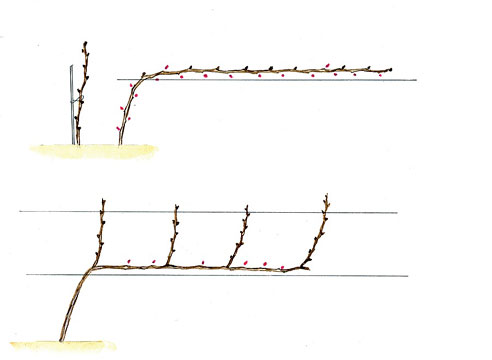
The essence of the scheme is to grow one shoot, which is cut off in the fall, leaving one eye on the bottom. In the future, a sleeve will grow from it.
In the next season, the shoot is fixed at an angle to the lower wire, the awakened eyes are broken out and the latter is left below. The upper eyes are also thinned out, leaving a gap of 30-35 cm.
In the fall of the second year of development, the vine is cut into 2-3 eyes, and the last is shortened to the full length of the sleeve. In the spring, the buds are broken out, leaving 2-3 shoots with an interval of 30-35 cm.
In the fall of the third year of development, two shoots appear on 2-3-eyed shoots. The lower shoots are pruned by 2-3 buds to obtain replacement knots, and the upper ones by 5-6 buds to obtain fruiting arrows.
Stamp spring pruning
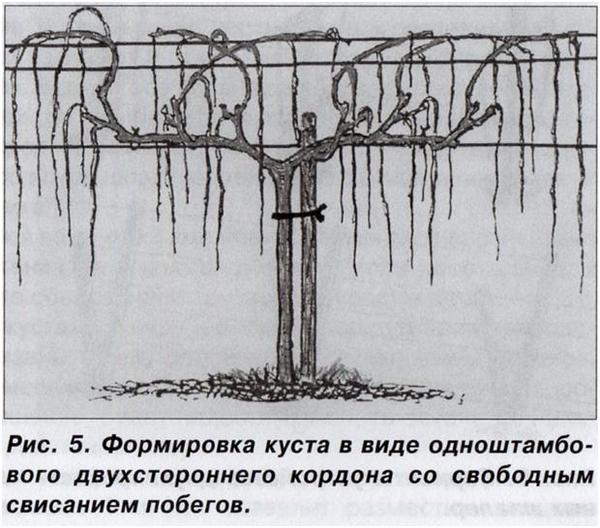
The procedure is appropriate for the age of the grapes. The method is used in the cultivation of covering varieties.
Trimming scheme:
- In the first year after landing seedlings are cut to two eyes to obtain two shoots. The rest of the shoots are removed completely.
- In the second year of development, the main shoot is shortened to 50-90 cm. For safety net, one more shoot is saved and cut to two eyes.
- In the third year, all shoots on the trunk are removed, except for the top two. Each of them is cut to two eyes and fixed to the support. In the fall, four shoots that have grown over the summer are cut off: the lower shoots are cut off to two eyes on all sides, the upper ones - up to 5-15 eyes.
- In the fourth year of development, fruiting branches are cut off, shoots from replacement knots form new fruit links. To do this, on each side of the bush, one shoot is cut off to 5-15 eyes, the second - up to two eyes.
Stampless spring pruning
This type of molding has its own subtleties and is used for uncovered grapes:
- A year after planting, dry, diseased branches are removed, leaving 10% of all young shoots, which are cut at a height of 2-3 cm above the second bud.
- In the second year, 60% of young shoots are cut off, leaving 2-3 of the strongest ones.
- In the third year, the lower vine, which acts as a replacement knot, is cut to two eyes, the fruit arrow (upper part) - to 7-14 eyes. Two vines are left on each sleeve, the rest are cut.
Spring pruning of fruiting grapes
This type of pruning provides for the observance of several nuances. In order to cut off a fruiting bush and not damage it, growers remove weak, damaged, thin and fattening shoots that have completed fruiting. Ripe branches with a diameter of 6-10 mm are left on the bushes.
Special pruning of damaged bushes
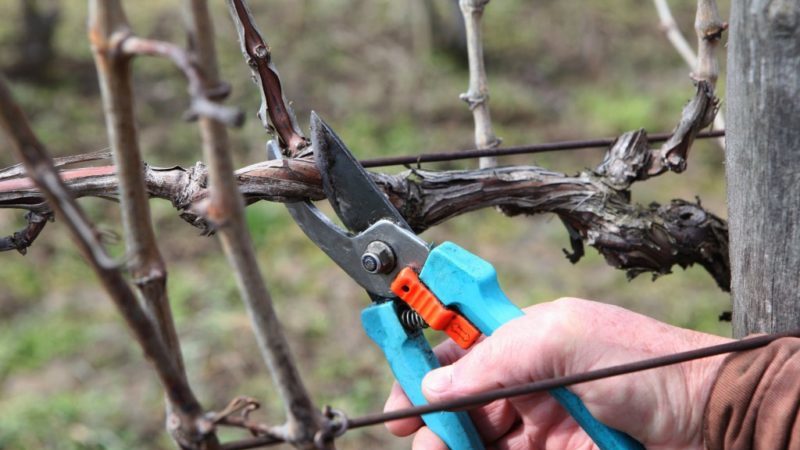
Spring pruning is carried out not only for the purpose of shaping the bushes, but also to restore the vine after winter, after unexpected return frosts and other weather surprises. Correct pruning can bring even badly damaged grapes back to life.
Frostbite in winter
If the bushes are very frozen in winter, first examine the buds and make cuts, moving from the base to the top. If the eyes are green, then everything is in order. Dark brown or black coloration indicates damage.
If less than 80% of the kidneys have died, more buds are left on the fruit links than with conventional pruning. The harvest will be able to be collected thanks to the additional shoots on the fruiting branches of fruiting left after the autumn pruning.
If more than 80% of the kidneys have died, perform sanitary pruning in two stages. To do this, until the buds bloom, the frozen shoots and sleeves are removed. After the appearance of greenery, cut off unnecessary growth.
With 100% kidney death inspecting stepchildren, who are distinguished by increased frost resistance. If the buds have died on them, they begin to form fruit links from the shoots (shoots of their underground part of the stem) or tops (fattening shoots).
When the entire above-ground part has died, a cut is made "for a black head": they dig in the bush to a depth of 25-30 cm and cut off all branches to a healthy node, and the stump is covered with soil with a layer of 5 cm. Soon young shoots will appear from the trunk. The strongest of them are left, the excess growth is cut off.
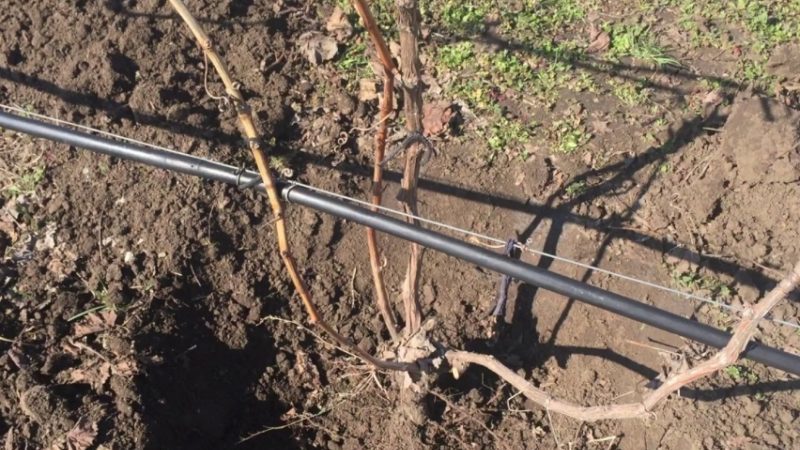
Frostbite roots
Partial frostbite or complete death of the root system of grapes occurs due to a little snowy winter. To check the condition of the roots, it is recommended that you dig in the soil in several places and make cuts. Healthy roots have a gray-white cut, frozen ones are dark brown.
With a root frostbite diameter of not more than 2.5 mm, there is no threat to the life of the plant; the main thing is that the main part of the rhizome remains intact. In case of partial frostbite, it is recommended to reduce the load on the vine by pruning the fruit shoots.
Hail damage
If after a strong hail the grapes have lost most of the leaves, young shoots are cut to 1-2 eyes. New shoots need to be thinned out to stimulate the growth of spare eyes, which will yield next season.
The consequences of a sharp cold snap
Spring frosts often coincide with the awakening of buds, so the death of young shoots, annual vines and eyes is not uncommon. In this case, growers perform short pruning of last year's branches to stimulate the growth of young shoots and new buds.
It is interesting:
How to water and feed grapes in spring: instructions for beginners
The best fertilizing of grapes in spring and the rules for their introduction
The nuances of pruning depending on the growing region
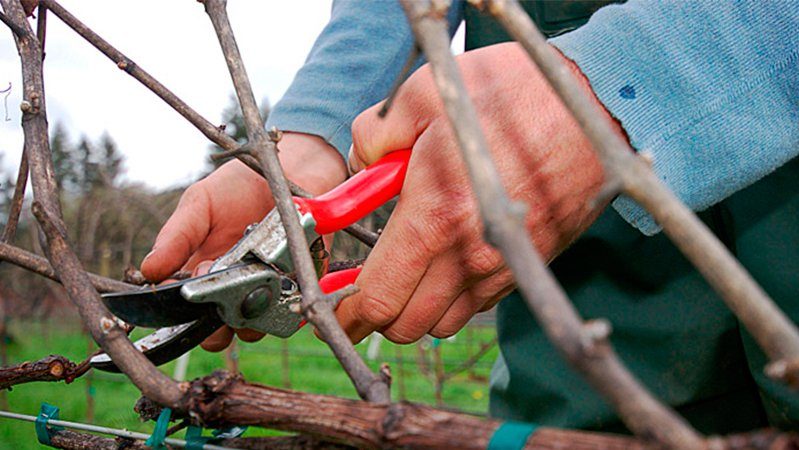
The preferred pruning methods for each region are:
- the scheme of the Moscow small fan is suitable for the northern regions;
- horizontal cordon formation is practiced in a northwestern climate;
- Guyot pruning is only suitable for the southern regions (Kuban).
Features of pruning young and old plants
Young grapes are pruned in order to give the crown a standard or bush shape, adjusting the number of shoulders and sleeves. Pruning of adult plants is performed in order to get rid of dry, diseased, damaged branches. On old bushes, 2-3 young shoots are left to replace the old vine.
Care after pruning
Any pruning is extremely stressful. Many wounds appear on the bushes, and grapes spend a lot of energy on restoring the integrity of the covers. Cuts with a circumference of more than 1.5 cm are especially dangerous. A large amount of damage weakens the plant and often becomes the cause of its death.
Compliance with a number of rules will help the plant to quickly restore vitality:
- It is recommended to use a sharp pruner to make even cuts when trimming thin shoots. A bow saw is suitable for removing thick branches, and a hacksaw can handle old thick branches.
- All slices should preferably be on one side. To achieve this result, the replacement shoots must be placed on one side during the annual pruning. Thanks to this arrangement, all branches will receive their portion of the nutrients.
- So that moisture does not linger on the surface of the cuts, the uneven edges are cleaned with a garden knife. Excess water penetrates into the deep layers of wood and leads to the development of putrefactive processes.
- After trimming a thick shoot, the height of the hemp should be less than 1 cm, otherwise it will crack.
- Thick and old branches are cut at a 90 ° angle to help wounds heal faster.
- Annual shoots are cut 1-2 cm above the lower eye.
Conclusion
Pruning grapes in spring helps to increase productivity and helps to give the bushes a neat shape. Correct pruning improves ventilation and solar heating. Neglecting pruning leads to thickening of plantings, reduced pollination and pea berries.
Winegrowers use different schemes: according to the Guyot methods, fan, horizontal cordon and Moscow small fan pruning. The method of standard pruning is used when growing covering grapes, without a standard - for non-covering. In addition, sanitary and anti-aging pruning will be performed in the spring to restore the plant's vitality after winter.